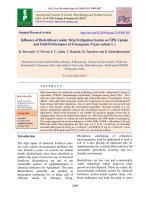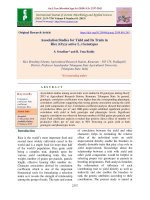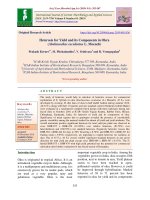Correlations and path analysis studies on yield and its components in mungbean (Vigna radiata (L.) Wilczek)
Bạn đang xem bản rút gọn của tài liệu. Xem và tải ngay bản đầy đủ của tài liệu tại đây (285.7 KB, 9 trang )
Int.J.Curr.Microbiol.App.Sci (2017) 6(5): 370-378
International Journal of Current Microbiology and Applied Sciences
ISSN: 2319-7706 Volume 6 Number 5 (2017) pp. 370-378
Journal homepage:
Original Research Article
/>
Correlations and Path Analysis Studies on Yield and its Components in
Mungbean (Vigna radiata (L.) Wilczek)
Rupal Dhoot1*, K.G. Modha1, Dhirendra Kumar1 and Meenakshi Dhoot2
1
Department of Genetics and Plant Breeding, Navsari Agricultural University,
Navsari-396450, Gujarat, India
2
Department of Plant Breeding and Genetics, MPUAT, Udaipur-313001, Rajasthan, India
*Corresponding author
ABSTRACT
Keywords
Mungbean,
Correlation
coefficient and
path analysis.
Article Info
Accepted:
04 April 2017
Available Online:
10 May 2017
The present research work was carried out at Navsari Agricultural University, Navsari
during the summer 2014 to study correlation among quantitative traits and their direct and
indirect effect on seed yield in F2 populations (Meha X Pusa Vishal, Meha X GM-4) of
mungbean. Correlation analysis revealed that seed yield was significantly and positively
correlated with pods per plants and harvest index in F2 population of Meha X Pusa Vishal
and with plant height, primary branches per plant, clusters per plant, pods per plant, straw
yield per plant and harvest index in F2 population of Meha X GM-4. It indicates that an
association of two characters is not only due to genes but also due to their influence of the
environment. The path coefficient analysis on phenotypic basis revealed that pods per
plant, plant height, clusters per plant, seeds per pod, 100 seed weight, straw yield per plant
and harvest index had positive direct effect and primary branches per plant had negative
direct effects on seed yield in both the populations, indicated that pods per plant directly
lead to increase in seed yield.
Introduction
Mungbean (Vigna radiata L. Wilczek) is a
short duration legume crop cultivated
primarily for their dry seeds. Annual
mungbean production in India is around 1.61
million tonnes from about 3.38 million ha
area (Anon., 2013-2014). The crops are
utilized in several ways, where seeds, sprouts
and young pods are consumed as sources of
protein, amino acids, vitamins and minerals,
and plant parts are used as fodder and green
manure. Mungbean protein is easily digested
without flatulence. They have ability to fix
atmospheric nitrogen (N2) in symbiosis with
the soil bacteria Rhizobium spp. They can be
grown successfully in extreme environments
(e.g., high temperatures, low rain fall, and
poor soils) with few economic inputs (Das et
al., 2014). The quantitative characters are the
best indicators of yield. Yield is a complex
character which is affected by a number of
component characters and the surrounding
environments. Thus, selection for grain yield
becomes difficult unless the associations
between yield contributing characters are
known. The statistics which measure the
degree and direction of association between
two or more variable is known as correlation.
Measurement of correlation helps to identify
the relative contribution of component
characters towards yield (Panse, 1957).
370
Int.J.Curr.Microbiol.App.Sci (2017) 6(5): 370-378
Indirect selection through component
character
with
high
heritability
is
advantageous for polygenic character like
yield.
Correlation
between
different
characters is an aspect which should be kept
in mind for better planning of selection
programs. Path analysis is carried out using
the estimates of correlation coefficients. Path
analysis gives idea about direct and indirect
influences of each of the component
characters towards dependent trait.
earlier workers Khajudparn and Tantasawat
(2011), Kumar et al., (2010b), Tabasum et al.,
(2010), Srivastava and Singh (2012), Gadakh
et al., (2013), Prasanna et al., (2013), Javed et
al., (2014) for pods per plant and Singh et al.,
(2009) for harvest index. While in F2
population of Meha X GM-4 it showed
significant and positive correlation with plant
height, primary branches per plant, clusters
per plant, pods per plant, straw yield per plant
and harvest index (Table 2). There are in
agreement with the results reported by
Tabasum et al., (2010) and Javed et al.,
(2014) for plant height; Khajudparn and
Tantasawat (2011), Gadakh et al., (2013),
Prasanna et al., (2013) for primary branches
per plant; Tabasum et al., (2010), Khajudparn
and Tantasawat (2011), Gadakh et al., (2013),
Prasanna et al., (2013) for clusters per plant;
Khajudparn and Tantasawat (2011), Kumar et
al., (2010), Tabasum et al., (2010), Srivastava
and Singh (2012), Gadakh et al., (2013),
Prasanna et al., (2013), Javed et al., (2014)
for pods per plant and (Singh et al., 2009) for
harvest index. It indicates that an association
of two characters is not only due to genes but
also due to their influence of the environment.
Hence, simultaneous selection based on these
characters
could
be
suggested
for
improvement of yield in segregating
populations.
Materials and Methods
The present research work was carried out at
Navsari Agricultural University, Navsari
during the summer 2014. We included 2 F2
populations of mungbean (Meha X Pusa
Vishal, Meha X GM-4) in this study.
Experiment was conducted in non-replicated
trial as it was segregating material. Each row
consisted of 20 plants with spacing of 45 cm x
15 cm inter and intra row spacing. Each F2
was raised with minimum of 300 plant
population and individual plant observations
were recorded from 100 randomly selected
plants. Observations were recorded for
following traits i.e. Days to flowering, Plant
height (cm), Days to maturity, Primary
branches per plant, Clusters per plant, Pods
per plant, Seeds per pod, 100-seed weight (g),
Seed yield per plant (g), Straw Yield (g) and
Harvest index (%). The simple correlations
(phenotypic) between different characters
were estimated according to Weber and
Moorthy (1952) and path-coefficient analysis
was carried out following Dewey and Lu
(1959).
Path coefficient analysis accommodates
assistance for categorizing the total
correlation into direct and indirect effects.
The results of path analysis showed table 3
and figure 1 (F2 of Meha X Pusa Vishal) and
table 4 and figure 2 (F2 of Meha X GM-4). In
both the F2 populations pods per plant had
maximum and positive direct effect on seed
yield. Some other characters like plant height,
clusters per plant, seeds per pod, 100 seed
weight, straw yield per plant and harvest
index also had positive direct effect in both
the population.
Results and Discussion
In the present study, seed yield per plant
recorded significant and positive correlation
with pods per plant and harvest index in F2
population of Meha X Pusa Vishal (Table 1).
These results are in close agreement with
371
Int.J.Curr.Microbiol.App.Sci (2017) 6(5): 370-378
Table.1 Phenotypic correlation coefficients of seed yield per plant with other characters in F2 \
population of Meha x Pusa Vishal in mungbean
Characters
DF
PH
PB
DM
CP
PP
SP
100 SW
ST Y
HI
SY
DF
1.0000
0.2820**
0.0775
0.6987**
0.1745
0.0991
-0.2102*
-0.0326
0.0584
-0.0059
0.0644
PH
PB
DM
CP
PP
SP
100 SW
ST Y
HI
SY
1.0000
0.1163
0.4357**
0.2478*
0.1069
-0.1480
0.0897
0.0637
-0.0559
0.1129
1.0000
-0.0249
0.4523**
-0.0296
-0.1190
-0.0763
-0.1207
0.0948
-0.0559
1.0000
0.0258
-0.0361
-0.1807
0.0658
0.0269
-0.0942
-0.0898
1.0000
0.0069
0.0056
0.0254
-0.2206*
0.1692
0.0739
1.0000
-0.2343*
-0.0041
0.1359
0.3324**
0.8794**
1.0000
0.0198
-0.0571
0.0838
-0.0427
1.0000
0.1537
-0.1204
0.0525
1.0000
-0.7164**
0.0804
1.0000
0.4215**
1.0000
Table.2 Phenotypic correlation coefficients of seed yield per plant with other characters in F2 population of
Meha x GM-4 in mungbean
Characters
DF
PH
PB
1.0000
DF
0.3434**
1.0000
PH
-0.3373** 0.0138
1.0000
PB
0.5884** 0.2164* -0.3100**
DM
-0.2584*
0.0912
0.6479**
CP
-0.0576
0.2076* 0.3300**
PP
0.0369
-0.0998
-0.1117
SP
0.1109
0.0289
-0.1318
100 SW
-0.0944
0.2902**
0.1551
ST Y
0.1154
-0.1811
0.0587
HI
-0.0307
0.2252* 0.3237**
SY
DM
CP
PP
SP
100 SW
ST Y
HI
SY
1.0000
-0.1188
-0.1291
-0.0040
0.1407
-0.0628
-0.0144
-0.1009
1.0000
0.3544**
-0.1460
-0.1205
0.3349**
-0.1069
0.3725**
1.0000
-0.2476*
-0.0332
0.3559**
0.3544**
0.9249**
1.0000
0.0041
0.0254
-0.0841
-0.0182
1.0000
0.0182
0.0813
0.1282
1.0000
-0.6212**
0.3868**
1.0000
0.3538**
1.0000
372
Int.J.Curr.Microbiol.App.Sci (2017) 6(5): 370-378
Table.3 Path coefficient analysis of component characters towards seed yield per plant in F2 population of
Meha x Pusa Vishal in mungbean
DF
PH
PB
DM
CP
PP
SP
100 SW
ST Y
HI
Phenotypic
correlation
with seed
yield
DF
0.0356
0.0173
-0.0048
-0.0539
0.0117
0.0771
-0.0253
-0.0018
0.0101
-0.0016
0.0644
PH
0.0100
0.0612
-0.0072
-0.0336
0.0166
0.0831
-0.0178
0.0049
0.0110
-0.0153
0.1129
PB
0.0028
0.0071
-0.0617
0.0019
0.0302
-0.023
-0.0143
-0.0041
-0.0209
0.0260
-0.0559
DM
0.0249
0.0267
0.0015
-0.0772
0.0017
-0.0281
-0.0217
0.0036
0.0047
-0.0258
-0.0898
CP
0.0062
0.0152
-0.0279
-0.0020
0.0668
0.0053
0.0007
0.0014
-0.0382
0.0464
0.0739
PP
0.0035
0.0065
0.0018
0.0028
0.0005
0.7779
-0.0282
-0.0002
0.0235
0.0912
0.8794**
SP
-0.0075
-0.0091
0.0073
0.0140
0.0004
-0.1822
0.1202
0.0011
-0.0099
0.0230
-0.0427
100 SW
-0.0012
0.0055
0.0047
-0.0051
0.0017
-0.0032
0.0024
0.0541
0.0266
-0.0330
0.0525
ST Y
0.0021
0.0039
0.0074
-0.0021
-0.0147
0.1058
-0.0069
0.0083
0.1732
-0.1966
0.0804
HI
-0.0002
-0.0034
-0.0058
0.0073
0.0113
0.2585
0.0101
-0.0065
-0.1241
0.2744
0.4215**
Characters
** - Significant at 1.0 per cent level of probability, * - Significant at 5.0 per cent level of probability
Residual = 0.1642
Bold diagonal figures are the direct effects
373
Int.J.Curr.Microbiol.App.Sci (2017) 6(5): 370-378
Table.4 Path coefficient analysis of component characters towards seed yield per plant in F2 population of Meha x GM-4 in mungbean
Characters
DF
PH
PB
DM
CP
PP
SP
100 SW
ST Y
HI
DF
PH
PB
DM
CP
PP
SP
100 SW
ST Y
HI
-0.0138
-0.0047
0.0047
-0.0081
0.0036
0.0008
-0.0005
-0.0015
0.0013
-0.0016
0.0199
0.0579
0.0008
0.0125
0.0053
0.0120
-0.0058
0.0017
0.0168
-0.0105
0.0008
00.00
-0.0025
0.0008
-0.0016
-0.0008
0.0003
0.0003
-0.0004
-0.0001
0.0018
0.0007
-0.0010
0.0031
-0.0004
-0.0004
00.00
0.0004
-0.0002
00.00
-0.0242
0.0085
0.0606
-0.0111
0.0935
0.0331
-0.0137
-0.0113
0.0313
-0.0100
-0.0466
0.1680
0.2670
-0.1045
0.2868
0.8092
-0.2003
-0.0269
0.2880
0.2868
0.0079
-0.0213
-0.0239
-0.0009
-0.0312
-0.0529
0.2137
0.0009
0.0054
-0.0180
0.0161
0.0042
-0.0192
0.0205
-0.0175
-0.0048
0.0006
0.1455
0.0026
0.0118
-0.0156
0.0478
0.0256
-0.0103
0.0552
0.0586
0.0042
0.0030
0.1648
-0.1024
0.0228
-0.0358
0.0116
-0.0029
-0.0211
0.0701
-0.0166
0.0161
-0.1229
0.1978
Phenotypic
correlation
with seed
yield
-0.0307
0.2252*
0.3237**
-0.1009
0.3725**
0.9249**
-0.0182
0.1282
0.3868**
0.3538**
** - Significant at 1.0 per cent level of probability, * - Significant at 5.0 per cent level of probability
Residual = 0.0559
Bold diagonal figures are the direct effect
DF - D a ys to f lo wer i n g
P B - P ri ma r y B r a n c he s p er p la n t
SP - S eed s p er p o d
ST Y - Str a w yi e ld p er p la nt ( g)
P H - P la n t he i g ht ( c m)
CP - Cl u s ter s p er p la n t
1 0 0 SW - 1 0 0 - se ed we i g ht ( g)
HI - Har ve s t i n d e x ( %)
374
DM - Da ys to ma t uri t y
P P - P o d s p er p l a nt
SY - S eed yi eld p er p la n t ( g)
Int.J.Curr.Microbiol.App.Sci (2017) 6(5): 370-378
Fig.1 Diagramatic presentation of factors influencing seed yield in mungbean (F2 generation of Meha x Pusa Vishal)
P21 0.0356
2
P31 0.0612
0.2820
3
P41 -0.062
0.0775
0.1163
4
P51 -0.077
-0.0249
5
P61 0.0668
Seed yield per
plant
1
P81 0.1202
-0.0361
9
R
0.1645
0.0584
0.0637
-0.1207
0.0269
-0.2206
0.1359
0.1537
0.0897
0.0658
-0.0571
-0.0326
-0.0763
0.0254
-0.0041
-0.0059
-0.0559
0.0948
-0.0942
0.1692
0.3324
0.0838
-0.1204
10
P111 0.2744
-0.1190
0.0056
0.0198
-0.2102
-0.1480
-0.1807
-0.2343
8
0.0991
0.1069
-0.0296
0.0069
7
P101 0.1732
0.2478
0.0258
P91 0.0541
0.1745
0.4523
6
P71 0.7779
0.6987
0.4357
-0.7164
11
x
Single arrow represents direct effect, cross lines joining horizontal lines represent indirect effect and R represents residual effect.
375
Int.J.Curr.Microbiol.App.Sci (2017) 6(5): 370-378
Fig.2 Diagramatic presentation of factors influencing seed yield in mungbean (F2 generation of Meha x GM-4)
P21 -0.0138
2
P31 0.0579
0.3434
3
P41 -0.0025
-0.3373
0.0138
4
P51 0.0031
-0.3100
5
P61 0.0935
P71 0.8092
1
P81 0.2137
9
-0.1318
-0.1205
0.3349
0.0254
-0.0944
0.2902
0.1551
-0.0628
0.3559
0.0182
0.1109
0.0289
0.1407
-0.0332
0.0587
-0.0144
-0.1069
0.3544
-0.0841
-0.6212
11
x
Single arrow represents direct effect, cross lines joining horizontal lines represent indirect effect and R represents residual effect.
376
0.1154
-0.1811
0.0813
10
0.0559
-0.0998
-0.0040
0.0041
0.0369
-0.1117
-0.1460
-0.2476
P111 0.1978
R
0.3300
0.3544
8
-0.0576
0.2076
-0.1291
7
P101 0.1648
0.0912
-0.1188
P91 0.1455
-0.2584
0.6479
6
Seed yield per
plant
0.5884
0.2164
Int.J.Curr.Microbiol.App.Sci (2017) 6(5): 370-378
The negative direct effects on seed yield by
primary branches per plant in both the
populations. The results are in accordance
with Kumar et al., (2010b), Vyas (2010),
Srivastava and Singh (2012), Prasanna et al.,
(2013) for plant height; Tabasum et al.,
(2010), Vyas (2010), Khajudparn and
Tantasawat (2011), Prasanna et al., (2013) for
primary branches per plant; Singh et al.,
(2009), Vyas (2010), Khajudparn and
Tantasawat (2011), Gadakh et al., (2013),
clusters per plant; Kumar et al., (2010),
Tabasum et al., (2010), Khajudparn and
Tantasawat (2011), Srivastava and Singh
(2012), Gadakh et al., (2013), Prasanna et al.,
(2013) for pods per plant; Singh et al., (2009),
Kumar et al., (2010b), Khajudparn and
Tantasawat (2011), Srivastava and Singh
(2012), Gadakh et al., (2013), Prasanna et al.,
(2013) for seeds per pod; Singh et al., (2009),
Tabasum et al., (2010), Vyas (2010),
Khajudparn
and
Tantasawat
(2011),
Srivastava and Singh (2012), Gadakh et al.,
(2013), prasanna et al., (2013) for 100 seed
weight; Kumar et al., (2010b), Tabasum et al.,
(2010), Vyas (2010), Gadakh et al., (2013),
Prasanna et al., (2013) for harvest index. But
days to flowering shows negative direct effect
in F2 of Meha X Pusa Vishal (Kumar et al.,
2010 and Prasanna et al., 2013)and positive
direct effect in F2 of Meha X GM-4 (Singh et
al., 2009; Vyas, 2010; Srivastava and Singh,
2012 and Gadakh et al., 2013) while for days
to maturity shows positive direct effect in F2
of Meha X Pusa Vishal (Kumar et al., 2010
and Prasanna et al., 2013) and negative direct
effect in F2 of Meha X GM-4 (Singh et al.,
2009 and Gadakh et al., 2013). Path analysis
revealed that number of pods per plant had
high direct effect, therefore, simple selection
for this character would be useful to
maximum seed yield. Considering all the
aspects together it is apparent from path
analysis that maximum effects as well as
appreciable indirect influences were exerted
by pods per plant, clusters per plant, straw
yield per plant and harvest index. These
characters also exhibited significant and
positive association with seed yield per plant.
Hence, they may be considered as the most
important yield contributing characters and
appropriate prominence should be placed on
these components while breeding for high
yielding types in mungbean.
References
Anonymous.
2011-2012.
/>Das, S., Das, S.S. and Ghosh, P. 2014. A
comparative analysis of genetic
diversity across certain mung bean and
urd bean cultivars of West Bengal,
using ISSR markers. Asian J. Plant Sci.
Res., 4: 56 - 61.
Deway, D.R. and Lu, K.H. 1959. A
correlation and path coefficient analysis
of components of crested wheat grass
seed production. Agron. J., 51: 515-518.
Gadakh, S.S., Dethe, A.M. and Kathale, M.N.
2013. Genetic variability, correlations
and path analysis studies on yield and
its components in mungbean [Vigna
radiata (L.) Wilczek]. Bioinfolet,
10(2A): 441 – 447.
Javed, I., Ahmad, H. M., Ahsan, M., Ali, Q.,
Ghani, M. U., Iqbal, M. S., Rashid, M.,
and Akram, H.N. 2014. Induced genetic
variability by gamma radiation and
traits association study in mungbean
(Vigna radiata L.). Life Sci. J., 11(8s):
530-539.
Khajudparn, P., and Tantasawat, P. 2011.
Relationships and variability of
agronomic and physiological characters
in mungbean. African J. Biotechnol.,
10(49): 9992-10000.
Kumar, N.V., Lavanya, G.R., Singh, S.K. and
Pandey, P. 2010. Genetic association
and path coefficient analysis in
mungbean [Vigna radiate (L.) Wilczek].
377
Int.J.Curr.Microbiol.App.Sci (2017) 6(5): 370-378
AAB Bioflux, 2(3): 251-258.
Prasanna, B.L., Rao, P.J.M., Murthy, K.G.K.
and Prakash, K.K. 2013. Genetic
variability, correlation and path
coefficient analysis in mungbean.
Environ. Ecol., 31(4): 1782-1788.
Singh, S.K., Singh, I.P., Singh, B.B. and
Singh, O. 2009. Correlation and path
coefficient studies for yield and its
components in mungbean (Vigna
radiate (L.) Wilczek). Legume Res.,
32(3): 180-185.
Srivastava, R.L. and Singh, G. 2012. Genetic
variability, correlation and path analysis
in mungbean [Vigna radiate (L.)
Wilczek]. Indian J. L. Sci., 2(1): 61-65.
Tabasum, A., Saleem, M. and Aziz, I. 2010.
Genetic variability, trait association and
path analysis of yield and yield
components in Mungbean (Vigna
radiata (L.)Wilczek). Pak. J. Bot.,
42(6): 3915-3924.
Vyas, Priyanka. 2010. Character Association
and Path Analysis under Two
Environments in Mungbean (Vigna
radiate (L.) Wilczek). Trends Biosci.,
3(1): 88-90.
Weber, C.R. and Moorthy, B.R. 1952.
Heritable and non-heritable relationship
and variabilities of oil content and
organic character in F2 generation of
soybean crosses. Agron. J., 44: 202-209.
How to cite this article:
Rupal Dhoot, K.G. Modha, Dhirendra Kumar and Meenakshi Dhoot. 2017. Correlations and
Path Analysis Studies on Yield and its Components in Mungbean (Vigna radiata (L.) Wilczek).
Int.J.Curr.Microbiol.App.Sci. 6(5): 370-378. doi: />
378



![Effect of fertility levels and stress mitigating chemicals on nutrient uptake, yield and quality of mungbean [Vigna radiata (L.) Wilczek] under loamy sand soil of Rajasthan](https://media.store123doc.com/images/document/2020_01/09/medium_ftp1578562755.jpg)
![Generation mean analysis for yield, yield components and MYMV disease scores in blackgram [Vigna mungo (L).Hepper]](https://media.store123doc.com/images/document/2020_01/09/medium_kiu1578565010.jpg)
![Studies on correlation and path analysis for grain yield and quality components in foxtail millet [Setaria italica (L.) Beauv.]](https://media.store123doc.com/images/document/2020_01/09/medium_dyd1578574836.jpg)



